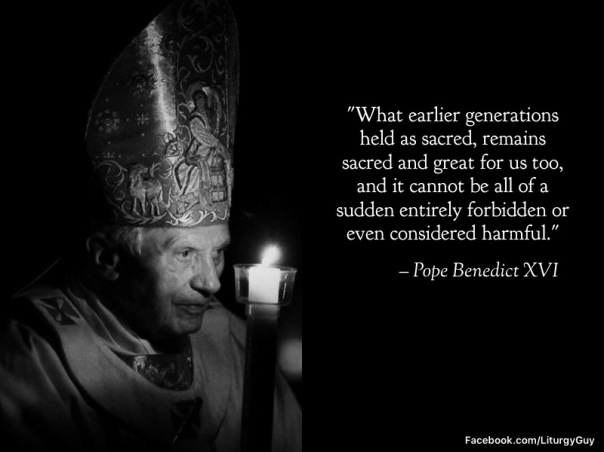Blog Archives
What Benedict Accomplished with Summorum Pontificum

On September 14 the Church celebrates the Feast of the Exaltation of the Holy Cross commemorating the 4th century recovery of the True Cross by St. Helena, mother of Emperor Constantine. This year the date also marks the tenth anniversary of the implementation of Pope Benedict’s landmark motu proprio, Summorum Pontificum. Thousands of words and hundreds of articles and books have been written in the last ten years celebrating the motu proprio and its significant impact upon the Church and her liturgy. More than any of its other accomplishments, however, Summorum Pontificum finally reaffirmed that the traditional Latin Mass (which Benedict labeled the Extraordinary Form) could no longer be marginalized by the Church.
What earlier generations held as sacred, remains sacred and great for us too, and it cannot be all of a sudden entirely forbidden or even considered harmful.
With this one sentence, with a mere twenty seven words (twenty seven thunderous words) Pope Benedict told the world’s bishops that the Traditional Latin Mass was sacred; that it had always been sacred and would always be sacred; and that none of the faithful could be harmed by a liturgy which had fed & formed Catholics for centuries. Seismic words which shook a liturgical landscape.
What earlier generations held as sacred, remains sacred and great for us too, and it cannot be all of a sudden entirely forbidden or even considered harmful.
These words were written to the world’s bishops in the Holy Father’s letter which accompanied Summorom Pontificum’s release. They were blunt words but necessary to say.
For decades episcopal ideologues had condemned the traditional Mass, ghettoized it, and demeaned its faithful adherents. While never formally abrogated, its suppression was nearly complete and universal. A de facto abrogation. With Summorum Pontificum the Mass of the Ages could no longer be marginalized.
This is not to say, however, that the persecution of tradition has ended. Of course it hasn’t. To claim such a thing would be ridiculous and naive. Far too many bishops still act as if Summorum was a non-event.
In recent years Rome has decried rigidity the greatest evil and many careerist are quick to echo those sentiments. For those who bristle at orthodoxy, who seek to innovate in matters of timeless doctrine, the timeless traditional liturgy is rightfully viewed as a threat to their agenda. Lex orandi, lex credendi, lex vivendi.
Ten years after Pope Benedict liberated the ancient Rite the ideologues still protest. Some wait for Rome to act. Rumors persist that Pope Francis will rescind it with his own motu proprio when the time is right, possibly when his predecessor passes.
Regardless of what the future holds in store, Benedict has already stated the irreversible liturgical truth: the traditional Mass can not be marginalized.
The legacy of Summorum Pontificum, indeed the victory of Summorum Pontificum, can be found in the very seminarians and priests formed and ordained during Benedict’s papacy. They are not ideologues of the post-conciliar revolution. They are simply men who have been introduced to tradition and who have responded to it. For them, what was sacred will always remain sacred. They will not unlearn this lesson.
Its victory can also be found in thriving traditional parishes, increased Mass attendance, and booming traditional orders and vocations. The faithful simply want to be fully Catholic once again, members of a Church that didn’t just begin in 1965.
If you are fortunate enough to have discovered the ancient Rite, be sure to thank God for such a blessing. Thank Him and hold nothing back. Immerse yourself in the supreme prayer of the Church, the Holy Sacrifice of the Mass, as it has been offered in the Roman Rite for centuries.
And in your kindness, please say a prayer for our pope emeritus Benedict as well.

